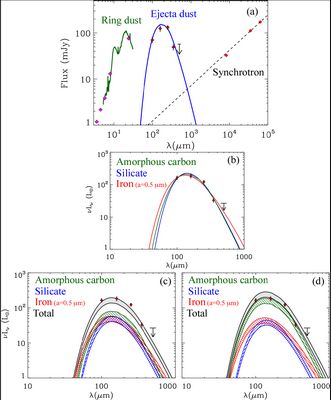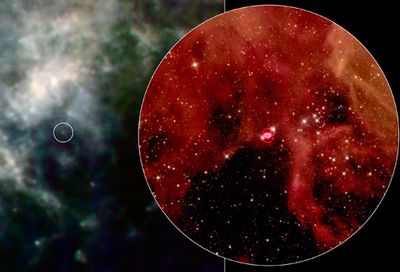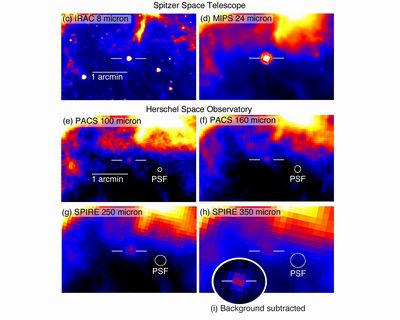We report far-infrared and submillimeter observations of Supernova 1987A, the star that exploded on February 23, 1987 in the Large Magellanic Cloud, a galaxy located 160,000 lightyears away. The observations reveal the presence of a population of cold dust grains radiating with a temperature of ~17–23 K at a rate of about 220 L⊙. The intensity and spectral energy distribution of the emission suggests a dust mass of ~0.4–0.7 M⊙. The radiation must originate from the SN ejecta and requires the efficient precipitation of all refractory material into dust. Our observations imply that supernovae can produce the large dust masses detected in young galaxies at very high redshifts.
Supernovae produce most of the heavy elements found in the Universe and disperse them into their surrounding galactic environment. They chemically enrich the material from which new generations of stars and planets are formed. SN 1987A exploded on 23 February 1987 in the Large Magellanic Cloud (LMC), only 50 kpc away. Because of its proximity, it has been possible to witness its evolution from explosion to remnant. SN 1987A has thus become one of the most extensively studied extragalactic objects, with ground, airborne, and space observatories covering a wide range of the electromagnetic spectrum. Here we report far-infrared and submillimeter (submm) observations of SN 1987A.

Figure 1: The Herschel images of SN 1987A together with the Spitzer infrared (20) and the Hubble optical (56, 57) images. North is top and east is left. The two vertical white lines indicate the position of SN 1987A measured from radio observations. (Inset i) Background-subtracted 350-μm image, where the background is estimated from the 250-μm residual image after the subtraction of the point spread function at the position of SN 1987A. The PSFs shows the resolution of the Herschel instruments. Panel (b) shows an enlarged HST optical image, indicating the morphology of the SN remnant. [Source: panel (a), the Hubble Heritage Team (AURA/STScI/NASA); panel (b), NASA, ESA, P. Challis and R. Kirshner (Harvard-Smithsonian Center for Astrophysics)].


Figure 2: (a) The infrared spectral energy distribution of SN 1987A. Herschel detected SN 1987A from 100 to 350 μm. An upper limit is given at 500 μm. The other observational data were collected from the literature: 5.8–24 μm photometric data and 5–30 μm spectra (20), which measures the warm dust emission; and the radio continuum (26, 29), which traces the synchrotron emission. (b): model fits to the far-infrared/submm dust emission using different single dust species. Parameters are given in Table 2. (c and d): The sum of the contributions from each dust species to the far-infrared/submm spectrum of SN 1987A. The flux at each wavelength is that derived from fitting the observed spectrum with each dust species alone (Table 2), scaled by the fraction of its mass available in the ejecta from abundance considerations (Table 4). The model 1 and model 2 abundances in Table 4 correspond to (c) and (d), respectively. The hatched areas represent the range of possible fluxes from each species, with the lower and upper boundaries corresponding, respectively, to the scaling of the minimum and maximum and dust masses (uncertainties in Table 2) required to produce the observed spectrum.
See the webside for more details. http://arxiv.org/abs/1107.1477 http://www.sciencemag.org/content/early/2011/07/06/science.1205983 (SY)




